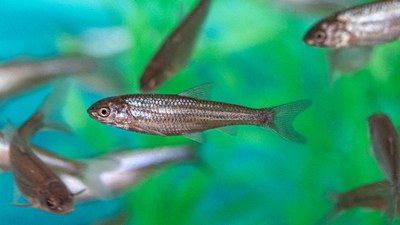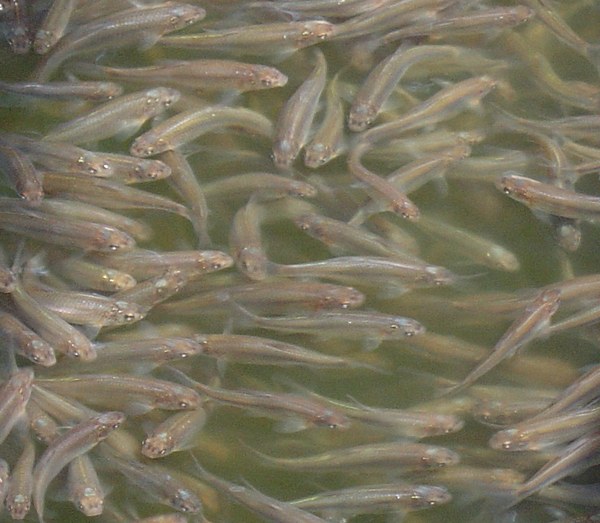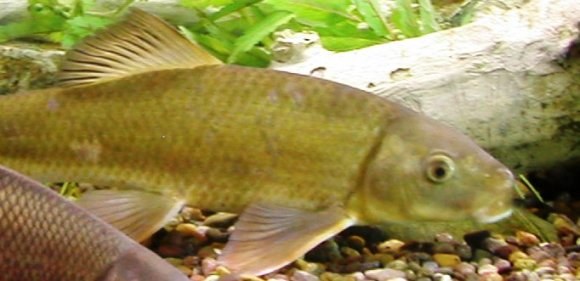Aquatic Conservation Facility
Scientists are working behind-the-scenes to save species native to NM's rivers and streams.
Species at the ACF include:
The ABQ BioPark's Aquatic Conservation Facility (ACF) was established in 2003 to help conserve and protect aquatic species that are native to New Mexico rivers. The ACF is operated in cooperation with the following agencies:
- United States Fish and Wildlife Service (USFWS)
- United States Bureau of Reclamation (USBR)
- New Mexico Department of Game and Fish (NMDGF)
- University of New Mexico, Museum of Southwestern Biology (MSB)
- Middle Rio Grande Endangered Species Act Collaborative Program (MRGESCP)
- Albuquerque Bernalillo County Water Utility Authority (ABCWUA)
What does the Aquatic Conservation Facility do?
The ACF holds refuge populations of several native fishes and invertebrates. These healthy, genetically diverse captive populations help ensure the survival of endangered species. They may be used to reintroduce or restore wild populations.
ACF staff also conducts ecological research on native fishes and invertebrates in order to understand what can be done to ensure their survival in the wild.
Why is conservation of aquatic animals important?
Every animal is part of an ecosystem--a community of plants, animals and other living organisms in conjunction with nonliving things like soil, air and water. The health of an ecosystem depends on all the interactions between its living and nonliving parts. If one of the parts stops working or disappears, the whole system becomes less healthy.
What species does the Aquatic Conservation Facility have right now?
The ACF houses the Rio Grande silvery minnow, Socorro isopod, blue sucker, gray redhorse and Zuni bluehead sucker.
Endangered and Imperiled Fish and Aquatic Invertebrates of New Mexico
Rio Grande Silvery Minnow, Hybognathus amarus
Endangered, Federal and State

The Rio Grande silvery minnow (RGSM) was listed as a federally endangered species in 1994. Historically, the fish inhabited the Pecos River and the Rio Grande from Espanola to the Gulf of Mexico. Today, RGSM cannot be found in the Pecos River, and their Rio Grande range has been significantly reduced. 
The BioPark started its Rio Grande silvery minnow program in 1999. Aquatic Conservation Facility (ACF) staff collects eggs from the Rio Grande in the spring, spawns RGSM in captivity, then releases minnows back into the river in the fall. ACF staff also researches egg and larval fish development rates, swimming speeds, flow velocity and turbidity, or cloudiness, of the river. Through this research, the ACF is able to design suitable fish passages in the river and determine what triggers spawning events in the wild. The ACF works closely with the USFWS and in accordance with the RGSM Recovery Plan in all collection, spawning and releasing activities.
Socorro Isopod, Thermosphaeroma thermophilum
Extinct in the wild
Socorro isopods historically inhabited Sedillo Spring, Socorro County, New Mexico. Humans modified Sedillo Spring to supply water to the city of Socorro. These modifications changed the spring's flow, and in 1988, Socorro isopods became extinct in the wild.
Conservationists reintroduced Socorro isopods to Sedillo Spring in 1995. Propagational facilities and regular habitat monitoring help develop a more secure isopod population.
In 1998, the Aquatic Conservation Facility (ACF) established refuge populations of Socorro isopods. These captive individuals contribute to the species' genetic diversity and vigor in the event that repatriation of wild populations is required. Staff also conducts recovery-related life history investigations.
Blue Sucker, Cycleptus elongatus
Endangered, State
The blue sucker is a New Mexico state endangered fish. It is a large bodied, elongate fish with a tapering cylindrical shape. It is rare or has been absent in recent surveys in the lower Pecos River and Black River below Carlsbad, NM. The ABQ BioPark currently maintains a captive population of seven blue suckers that are suspected to be the only representatives of the species remaining in the state of New Mexico. Though the blue sucker is abundant throughout the Mississippi River Basin, there are differences in the Rio Grande basin blue sucker that may indicate it as a unique species. Habitat fragmentation and oil and gas industry activities may be contributing factors to the rarity of this fish.
Gray Redhorse, Moxostoma congestum
Threatened, State

The gray redhorse is a large sucker that is New Mexico State listed as threatened. Water depletion and introduction of non-native fishes may be contributing to its decline in New Mexico. It is uncommon in its historical range of the lower Pecos and Black Rivers in New Mexico and is the only species of the genus Moxastoma that occurs in the state. There are currently nine gray redhorse being held at the ABQ BioPark.
Zuni Bluehead Sucker, Catostomus discobolus yarrowi
Endangered, State
The Zuni bluehead sucker is a New Mexico state endangered fish found in the Zuni River and its tributaries. Five isolated populations of this Zuni bluehead sucker have been identified, and there may only be a few hundred individuals total. All are threatened by habitat degradation and competition with non-native species. The ABQ BioPark currently maintains a captive population representing two of the five wild populations. They have successfully reproduced a number of times since 2007.
